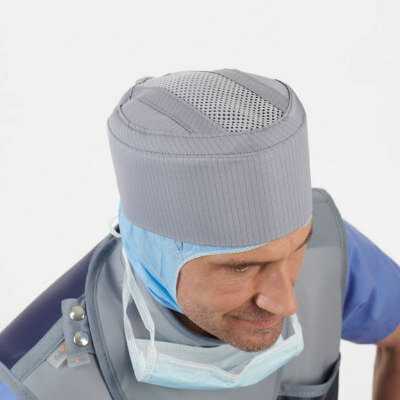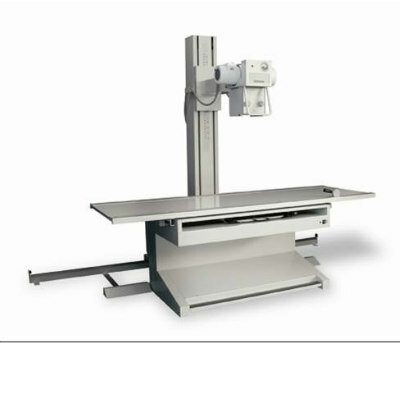Compact Radiation System Delivers Conformal RT Treatments
|
By MedImaging International staff writers Posted on 23 Jan 2018 |

Image: The S250i proton therapy system with Hyperscan PBS (Photo courtesy of Mevion Medical Systems).
Novel pencil beam scanning (PBS) technology uses hyperscanning to deliver faster, sharper, and more robust radiation therapy (RT) treatments.
The Mevion Medical Systems (Mevion; Littleton, MA, USA) S250i Proton Therapy System with Hyperscan PBS technology is designed to shape the delivered radiation dose by “painting” tumors spot-by-spot and layer-by-layer with the sub-atomic proton particles. Hyperscan technology helps overcome clinical challenges faced by first generation PBS systems by reducing delivery times to less than five seconds, thus reducing errors resulting that can undermine the high precision of PBS due to the target tumor shifting under normal organ motion, such as breathing.
In addition to Hyperscan, the system utilizes an adaptive, robotically controlled aperture proton multi-leaf collimator (pMLC), which is capable of trimming the edges of the beam at every layer of delivery. This capability can deliver up to a three times sharper drop off in radiation at the delivery field edge, sparing healthy tissue and limiting unnecessary radiation to sensitive locations. As other members of the S250 Series platform, the S250i includes a gantry mounted superconducting synchrocyclotron, a six degree-of-freedom treatment couch, and advanced in-room image guidance.
“Delivering sharp field edges has been a real challenge for PBS, especially in shallow fields. In intracranial procedures, where critical structures are in close proximity to tumors at shallow depths, having the sharpest lateral penumbra is essential,” said Skip Rosenthal, VP of clinical education at Mevion. “The sharp penumbras of the adaptive aperture system have substantial benefits for these patients. In addition, the enhanced speed of Hyperscan PBS could enable greater confidence in treating thoracic tumors.”
Proton therapy is a precise form of RT that uses charged particles instead of x-rays. It can be a more effective form of treatment than conventional radiotherapy as it directs the RT more precisely, with minimal damage to surrounding tissue. Evidence is growing that protons can be effective in treating a number of cancers, in particular in children and young people with brain tumors, for whom it appears to produce fewer side effects such as secondary cancers, growth deformity, hearing loss, and learning difficulties.
The Mevion Medical Systems (Mevion; Littleton, MA, USA) S250i Proton Therapy System with Hyperscan PBS technology is designed to shape the delivered radiation dose by “painting” tumors spot-by-spot and layer-by-layer with the sub-atomic proton particles. Hyperscan technology helps overcome clinical challenges faced by first generation PBS systems by reducing delivery times to less than five seconds, thus reducing errors resulting that can undermine the high precision of PBS due to the target tumor shifting under normal organ motion, such as breathing.
In addition to Hyperscan, the system utilizes an adaptive, robotically controlled aperture proton multi-leaf collimator (pMLC), which is capable of trimming the edges of the beam at every layer of delivery. This capability can deliver up to a three times sharper drop off in radiation at the delivery field edge, sparing healthy tissue and limiting unnecessary radiation to sensitive locations. As other members of the S250 Series platform, the S250i includes a gantry mounted superconducting synchrocyclotron, a six degree-of-freedom treatment couch, and advanced in-room image guidance.
“Delivering sharp field edges has been a real challenge for PBS, especially in shallow fields. In intracranial procedures, where critical structures are in close proximity to tumors at shallow depths, having the sharpest lateral penumbra is essential,” said Skip Rosenthal, VP of clinical education at Mevion. “The sharp penumbras of the adaptive aperture system have substantial benefits for these patients. In addition, the enhanced speed of Hyperscan PBS could enable greater confidence in treating thoracic tumors.”
Proton therapy is a precise form of RT that uses charged particles instead of x-rays. It can be a more effective form of treatment than conventional radiotherapy as it directs the RT more precisely, with minimal damage to surrounding tissue. Evidence is growing that protons can be effective in treating a number of cancers, in particular in children and young people with brain tumors, for whom it appears to produce fewer side effects such as secondary cancers, growth deformity, hearing loss, and learning difficulties.
Latest Nuclear Medicine News
- New SPECT/CT Technique Could Change Imaging Practices and Increase Patient Access
- New Radiotheranostic System Detects and Treats Ovarian Cancer Noninvasively
- AI System Automatically and Reliably Detects Cardiac Amyloidosis Using Scintigraphy Imaging
- Early 30-Minute Dynamic FDG-PET Acquisition Could Halve Lung Scan Times
- New Method for Triggering and Imaging Seizures to Help Guide Epilepsy Surgery
- Radioguided Surgery Accurately Detects and Removes Metastatic Lymph Nodes in Prostate Cancer Patients
- New PET Tracer Detects Inflammatory Arthritis Before Symptoms Appear
- Novel PET Tracer Enhances Lesion Detection in Medullary Thyroid Cancer
- Targeted Therapy Delivers Radiation Directly To Cells in Hard-To-Treat Cancers
- New PET Tracer Noninvasively Identifies Cancer Gene Mutation for More Precise Diagnosis
- Algorithm Predicts Prostate Cancer Recurrence in Patients Treated by Radiation Therapy
- Novel PET Imaging Tracer Noninvasively Identifies Cancer Gene Mutation for More Precise Diagnosis
- Ultrafast Laser Technology to Improve Cancer Treatment
- Low-Dose Radiation Therapy Demonstrates Potential for Treatment of Heart Failure
- New PET Radiotracer Aids Early, Noninvasive Detection of Inflammatory Bowel Disease
- Combining Amino Acid PET and MRI Imaging to Help Treat Aggressive Brain Tumors
Channels
Radiography
view channel
Novel Breast Imaging System Proves As Effective As Mammography
Breast cancer remains the most frequently diagnosed cancer among women. It is projected that one in eight women will be diagnosed with breast cancer during her lifetime, and one in 42 women who turn 50... Read more
AI Assistance Improves Breast-Cancer Screening by Reducing False Positives
Radiologists typically detect one case of cancer for every 200 mammograms reviewed. However, these evaluations often result in false positives, leading to unnecessary patient recalls for additional testing,... Read moreMRI
view channel
PET/MRI Improves Diagnostic Accuracy for Prostate Cancer Patients
The Prostate Imaging Reporting and Data System (PI-RADS) is a five-point scale to assess potential prostate cancer in MR images. PI-RADS category 3 which offers an unclear suggestion of clinically significant... Read more
Next Generation MR-Guided Focused Ultrasound Ushers In Future of Incisionless Neurosurgery
Essential tremor, often called familial, idiopathic, or benign tremor, leads to uncontrollable shaking that significantly affects a person’s life. When traditional medications do not alleviate symptoms,... Read more
Two-Part MRI Scan Detects Prostate Cancer More Quickly without Compromising Diagnostic Quality
Prostate cancer ranks as the most prevalent cancer among men. Over the last decade, the introduction of MRI scans has significantly transformed the diagnosis process, marking the most substantial advancement... Read moreUltrasound
view channel
Deep Learning Advances Super-Resolution Ultrasound Imaging
Ultrasound localization microscopy (ULM) is an advanced imaging technique that offers high-resolution visualization of microvascular structures. It employs microbubbles, FDA-approved contrast agents, injected... Read more
Novel Ultrasound-Launched Targeted Nanoparticle Eliminates Biofilm and Bacterial Infection
Biofilms, formed by bacteria aggregating into dense communities for protection against harsh environmental conditions, are a significant contributor to various infectious diseases. Biofilms frequently... Read moreGeneral/Advanced Imaging
view channel
New AI Method Captures Uncertainty in Medical Images
In the field of biomedicine, segmentation is the process of annotating pixels from an important structure in medical images, such as organs or cells. Artificial Intelligence (AI) models are utilized to... Read more.jpg)
CT Coronary Angiography Reduces Need for Invasive Tests to Diagnose Coronary Artery Disease
Coronary artery disease (CAD), one of the leading causes of death worldwide, involves the narrowing of coronary arteries due to atherosclerosis, resulting in insufficient blood flow to the heart muscle.... Read more
Novel Blood Test Could Reduce Need for PET Imaging of Patients with Alzheimer’s
Alzheimer's disease (AD), a condition marked by cognitive decline and the presence of beta-amyloid (Aβ) plaques and neurofibrillary tangles in the brain, poses diagnostic challenges. Amyloid positron emission... Read more.jpg)
CT-Based Deep Learning Algorithm Accurately Differentiates Benign From Malignant Vertebral Fractures
The rise in the aging population is expected to result in a corresponding increase in the prevalence of vertebral fractures which can cause back pain or neurologic compromise, leading to impaired function... Read moreImaging IT
view channel
New Google Cloud Medical Imaging Suite Makes Imaging Healthcare Data More Accessible
Medical imaging is a critical tool used to diagnose patients, and there are billions of medical images scanned globally each year. Imaging data accounts for about 90% of all healthcare data1 and, until... Read more
Global AI in Medical Diagnostics Market to Be Driven by Demand for Image Recognition in Radiology
The global artificial intelligence (AI) in medical diagnostics market is expanding with early disease detection being one of its key applications and image recognition becoming a compelling consumer proposition... Read moreIndustry News
view channel
Bayer and Google Partner on New AI Product for Radiologists
Medical imaging data comprises around 90% of all healthcare data, and it is a highly complex and rich clinical data modality and serves as a vital tool for diagnosing patients. Each year, billions of medical... Read more





















